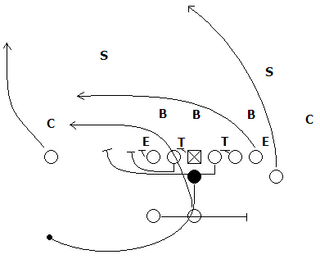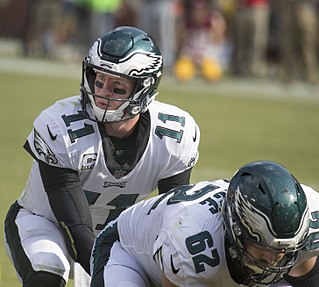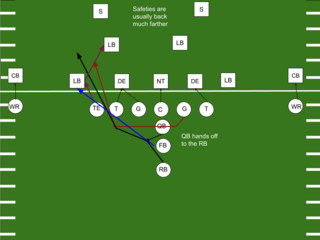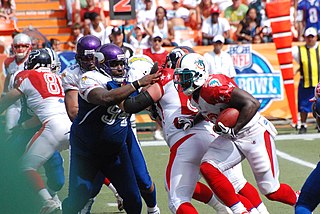Related Research Articles

In gridiron football, a lineman is a player who specializes in play at the line of scrimmage. The linemen of the team currently in possession of the ball are the offensive line, while linemen on the opposing team are the defensive line. A number of NFL rules specifically address restrictions and requirements for the offensive line, whose job is to help protect the quarterback from getting sacked for a loss, or worse, fumbling. The defensive line is covered by the same rules that apply to all defensive players. Linemen are usually the largest players on the field in both height and weight, since their positions usually require less running and more strength than skill positions.

Linebacker (LB) is a playing position in gridiron football. Linebackers are members of the defensive team, and typically line up three to five yards behind the line of scrimmage and the defensive linemen, playing closer to the line of scrimmage than the defensive backs (secondary).
Strategy plays a crucial role in American football. Both teams carefully plan various aspects of their gameplay in an effort to win. This includes deciding on formations, selecting players for specific positions, and assigning roles and instructions to each player on offense and defense.

In American football, a bootleg play is a play in which the quarterback runs with the ball in the direction of either sideline behind the line of scrimmage. This can be accompanied by a play action, or fake hand off of the ball to a running back running the opposite direction.

The 46 defense is an American football defensive formation, an eight men in the box defense, with six players along the line of scrimmage. There are two players at linebacker depth playing linebacker technique, and then three defensive backs. The 46 defense was originally developed and popularized with the Chicago Bears by their defensive coordinator Buddy Ryan, who later became head coach of the Philadelphia Eagles and Arizona Cardinals.
A formation in American football refers to the position players line up in before the start of a down. There are both offensive and defensive formations and there are many formations in both categories. Sometimes, formations are referred to as packages.

In sports, a starting lineup is an official list of the set of players who will participate in the event when the game begins. The players in the starting lineup are commonly referred to as starters, whereas the others are substitutes or bench players.

Center or centre (C) is a position in American football. The center is the innermost lineman of the offensive line on a football team's offense who passes the ball between his legs to the quarterback at the start of each play.

In American football, a guard (G), otherwise known as an offensive guard (OG), is a player who lines up between the center and the tackles on the offensive line of a football team on the line of scrimmage used primarily for blocking. Right guards (RG) is the term for the guards on the right of the offensive line, while left guards (LG) are on the left side. Guards are to the right or left of the center.
A trick play, also known as a gadget play, gimmick play or trickeration, is a play in gridiron football that uses deception and unorthodox tactics to fool the opposing team. A trick play is often risky, offering the potential for a large gain or a touchdown if it is successful, but with the chance of a significant loss of yards or a turnover if not. Trick plays are rarely used not only because of the riskiness, but also to maintain the element of surprise for when they are used.

In American football, the specific role that a player takes on the field is referred to as their "position". Under the modern rules of American football, both teams are allowed 11 players on the field at one time and have "unlimited free substitutions", meaning that they may change any number of players during any "dead ball" situation. This has resulted in the development of three task-specific "platoons" of players within any single team: the offense, the defense, and "special teams". Within these three separate "platoons", various positions exist depending on the jobs that the players are doing.

The triple option is an American football play used to offer six ways to move the football forward on the field of play. The triple option is based on the option run, but uses three players who might run with the ball instead of the two used in a standard option run.
In American football, a play is a close-to-the-ground plan of action or strategy used to move the ball down the field. A play begins at either the snap from the center or at kickoff. Most commonly, plays occur at the snap during a down. These plays range from basic to very intricate. Football players keep a record of these plays in a playbook.

In American football, a power run is a running play used out of a variety of offensive formations using two backs.

In American football, the 3–4 defense is a common defensive alignment consisting of three down linemen and four linebackers. It is called a "base defense" because it will readily switch to other defensive alignments as circumstances change. Alternatively, some defenses use a 4–3 defense: four down linemen and three linebackers.

In American football, a 4–3 defense is a defensive alignment consisting of four down linemen and three linebackers. It is called a "base defense" because it is the default defensive alignment used on "base downs". However, defenses will readily switch to other defensive alignments as circumstances change. Alternatively, some teams use a 3–4 defense.
The following terms are used in American football, both conventional and indoor. Some of these terms are also in use in Canadian football; for a list of terms unique to that code, see Glossary of Canadian football.

A defensive tackle (DT) is a position in American football that typically lines up on the line of scrimmage, opposite one of the offensive guards; however, he may also line up opposite one of the offensive tackles. Defensive tackles are typically the largest and strongest of the defensive players. Depending on a team's defensive scheme, a defensive tackle may be called upon to fill several different roles. These may include merely holding the point of attack by refusing to be moved, or penetrating a certain gap between offensive linemen to break up a play in the opponent's backfield. If a defensive tackle reads a pass play, his primary responsibility is to pursue the quarterback, or simply knock the pass down at the line if it is within arm's reach. Other responsibilities of the defensive tackle may be to pursue the screen pass or drop into coverage in a zone blitz scheme. In a traditional 4–3 defense, there is no nose tackle. Instead there are a left and a right defensive tackle. Some teams, especially in the National Football League (NFL), have a nose tackle in this scheme, but most of them do not.

Pulling is when a blocking player in American football leaves his usual spot in order to pick up another assignment on the opposite side of the field, running behind the other offensive linemen, to sprint out in front of a running back and engage a defensive player beyond the initial width of the offensive line.
The Packers sweep, also known as the Lombardi sweep, is an American football play popularized by Green Bay Packers coach Vince Lombardi. The Packers sweep is based on the sweep, a football play that involves a back taking a handoff and running parallel to the line of scrimmage before turning upfield behind lead blockers. The play became noteworthy due to its extensive use by the Packers in the 1960s, when the team won five National Football League (NFL) Championships, as well as the first two Super Bowls. Lombardi used the play as the foundation on which the rest of the team's offensive game plan was built. The dominance of the play, as well as the sustained success of Lombardi's teams in the 1960s, solidified the Packers sweep's reputation as one of the most famous football plays in history.
References
- ↑ "Running Plays in Football". dummies.com.
- ↑ "Life in the Red's Blog | Osborne's innovation". Archived from the original on 2010-07-18. Retrieved 2010-07-15.